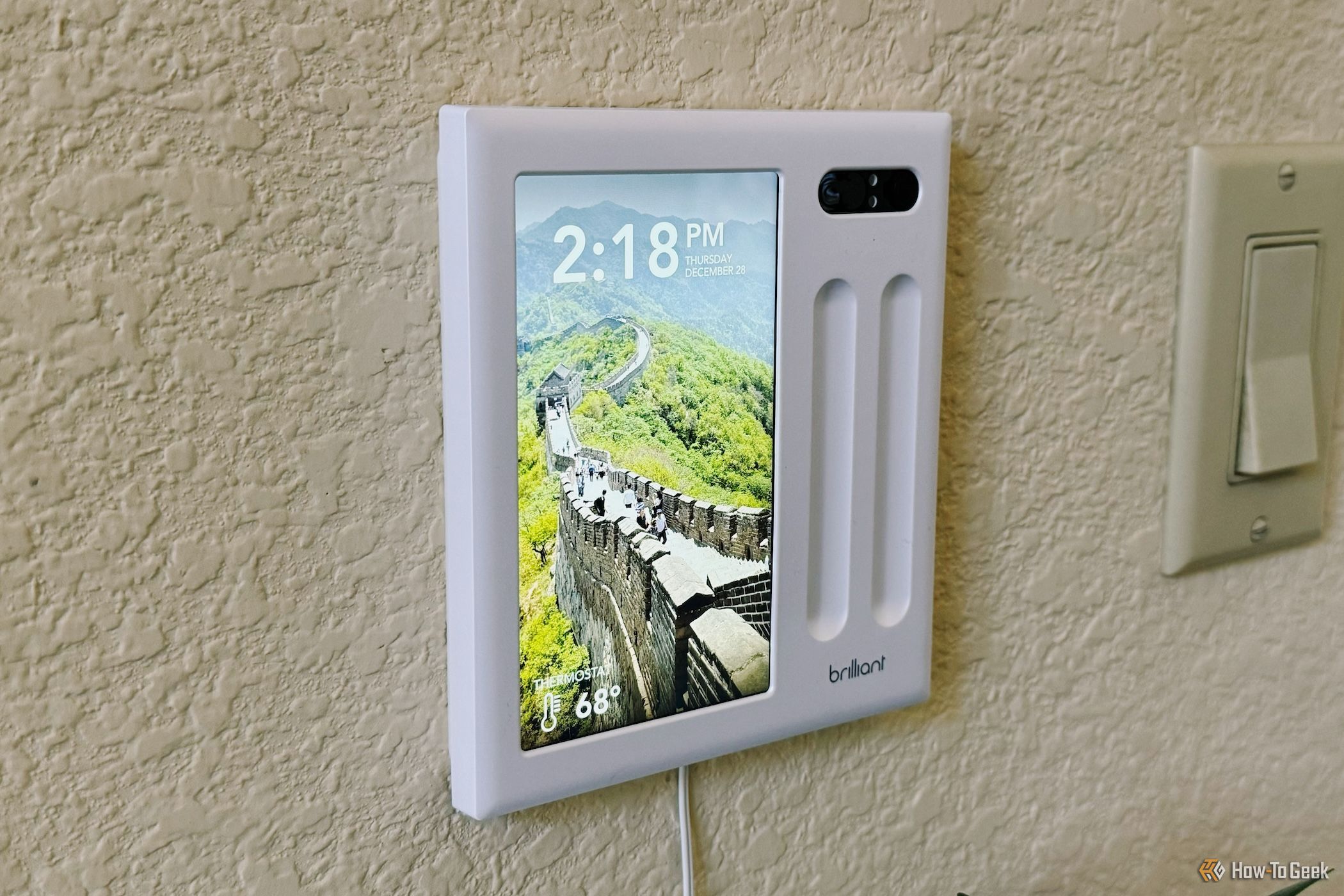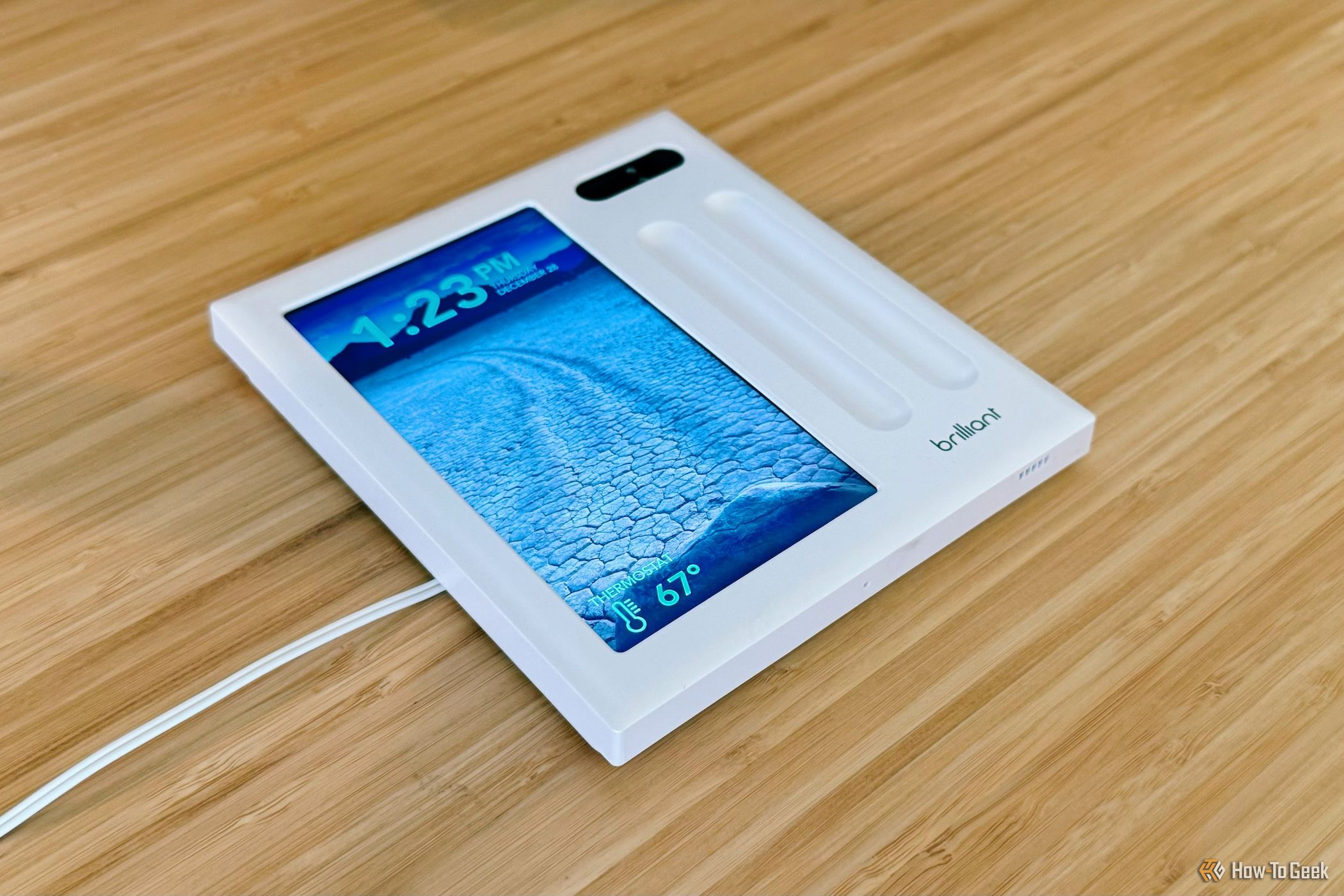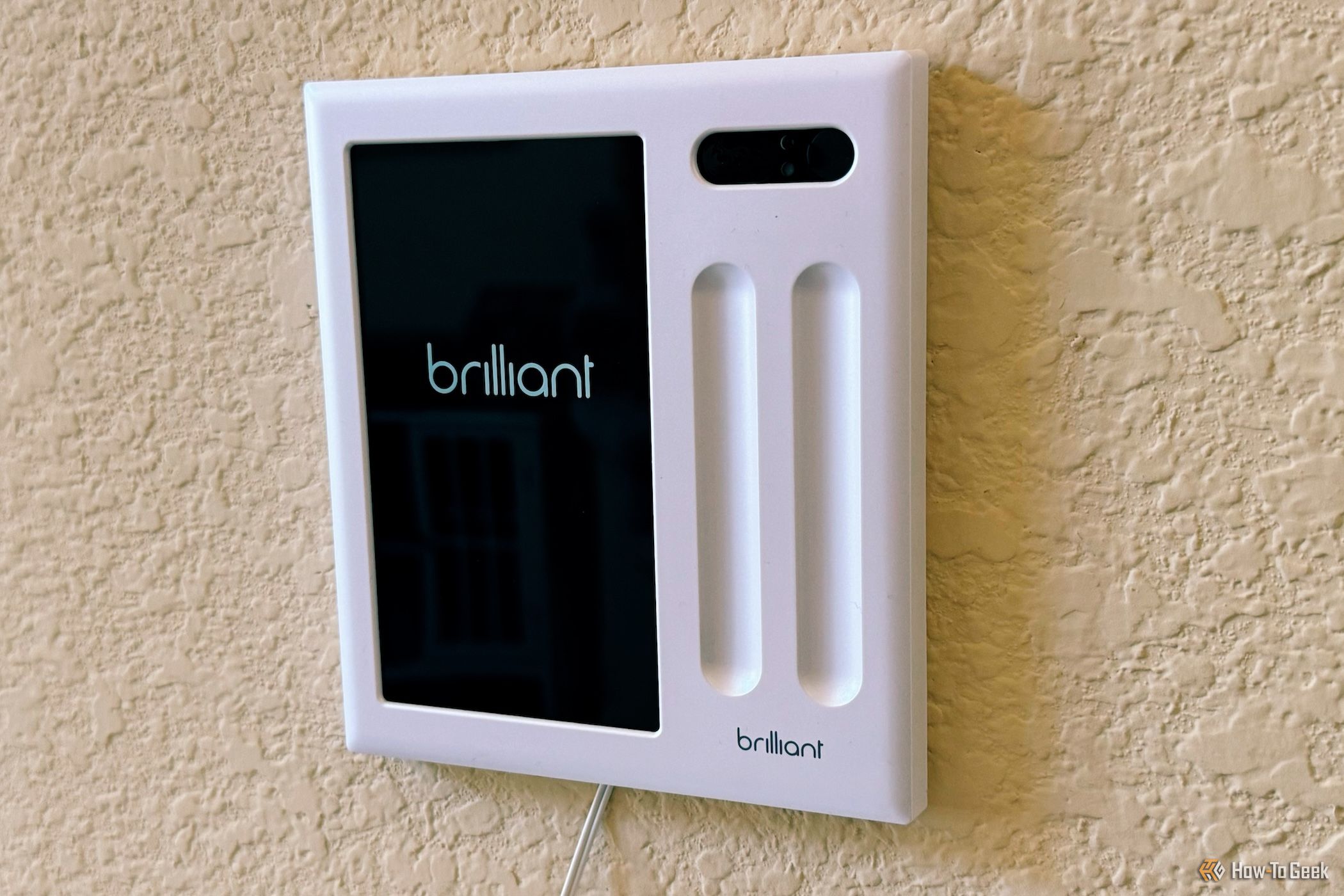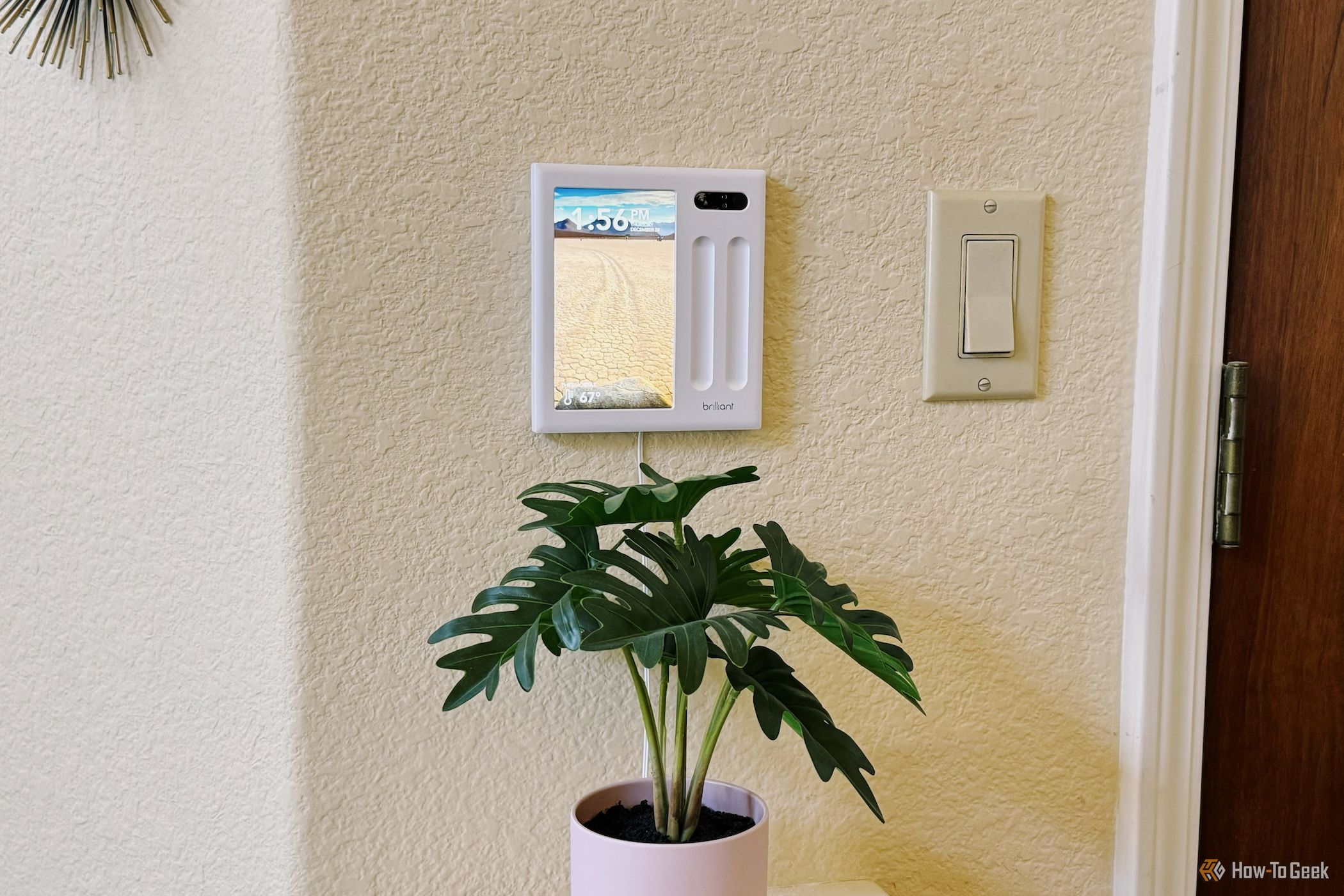Key Takeaways
- Brilliant's Plug-In Panel is a touchscreen controller that plugs into a regular AC wall outlet, making it easier for smart home enthusiasts to try out.
- The panel has a responsive touchscreen and can integrate various smart home devices, but it may not cover all products someone has.
- While the panel is useful for controlling lights and triggering Sonos speakers, it can be cumbersome to navigate and introduces another potential troubleshooting step.
Anyone who knows they have a lot of smart home products and thinks another smart home product is the solution to their chaos is a perfect candidate for Brilliant’s Smart Home Control—a touchscreen controller that comes in varying sizes. For people in that predicament, but aren’t confident in their electrical skills, Brilliant’s new Plug-In Panel is the optimal solution.
The Plug-In Panel’s wiring doesn’t need to be inside the wall and plugs into a regular AC wall outlet. Even after spending some time with it, I’m still not convinced it’s needed in every smart home, but it certainly gives enthusiasts an easier way to see if a Brilliant control is for them.
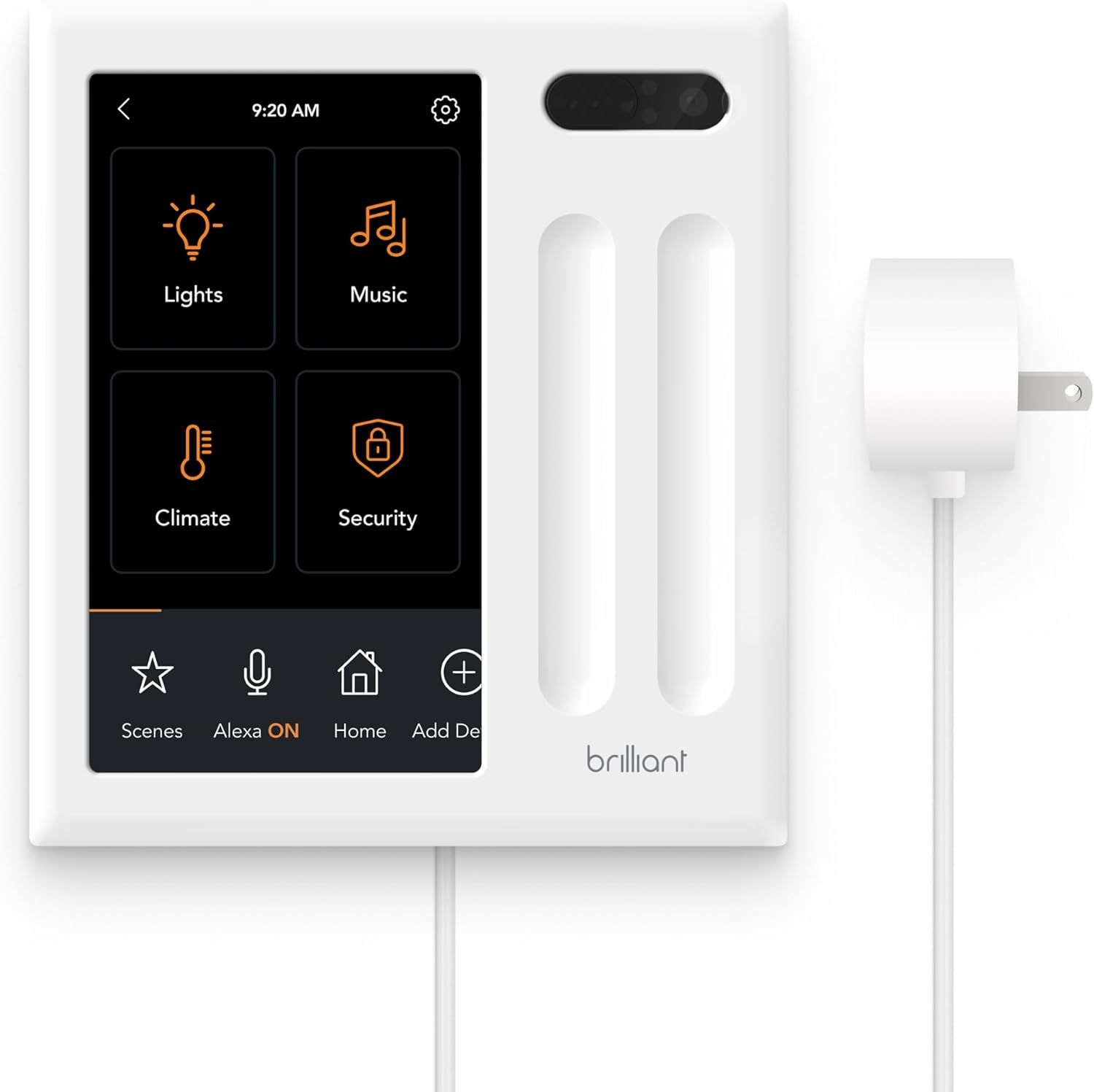
Brilliant Plug-In Panel
This Brilliant Plug-in Panel flush mounts to any wall and plugs into any outlet. Includes a 5" LCD touchscreen, built-in camera with privacy shutter, and built-in motion sensor.
- Power Source
- AC outlet
- Smartphone compatible?
- iOS and Android
- Screen
- 5-inch LCD touchscreen
- Sensors
- built-in camera with privacy shutter, and built-in motion sensor.
- Vivid, responsive touchscreen
- Lots of extendability and features for advanced users
- Blends multiple devices/brands together with scenes
- Ultimately still creates potential for smart home chaos
- Touch strips can be slow to respond
- Too few quick-access shortcuts
- Integrated camera needs a second Brilliant panel
Responsive Touchscreen Works Surprisingly Well
As a quick overview, this new Brilliant Plug-In Panel is nearly identical to its other 2-Switch Panel. Instead of needing in-wall electrical wiring, the new unit connects to a wall outlet via a thin wire with a USB-A plug on the end.
The color touchscreen is vibrant and sharp. It was more responsive than I expected it to be. Even weeks after initially unboxing the unit, I was still dazzled by the glossy screen cycling through landscape images whenever I passed by it and the motion sensor lit it up.
The touch-sensitive vertical strips were also responsive enough, though they could be a little tricky to tap without accidentally sliding a finger across. For example, I have the strips set to turn on lights in different rooms so I can tap a strip to turn them on fully or slide up to turn them on in a dimmed state. Sometimes, taps were registered as slides and vice versa.
Beyond the motion sensor, there's also a camera integrated into the unit above the touch strips. It's intended to be used from one control panel to another and is a compelling reason to get more than one. But I was able to test it from the Brilliant app. The video from the tiny camera was dark and grainy. It really needs a lot of light in the room. Talking from my phone to the Plug-In Panel was also delayed enough that it was annoying to use.
Plenty of Products Connect, But Not Everything Is Covered
It might not be immediately clear to everyone, but Brilliant is playing the intermediary here, working with dozens of companies, and harnessing their APIs to get as many smart home devices as possible integrated into their system. You’ll need to jump out to different company sites and sign in to authorize access, but otherwise, the process is seamless and fairly invisible.
What Brilliant is doing is not a small task, so I was impressed by how cohesive the process was to integrate various products. There are some oddities, however. I couldn’t add Hue lights from the app and had to do that from the Plug-In Panel itself. The first day, my Nest cameras wouldn’t show up despite enabling all the permissions. The cameras showed up just fine the next day.
In total, I went through the setup and added over 50 devices that included Philips Hue lights, Nest cameras, Sonos speakers, a Yale lock, and an Ecobee thermostat. From there, Brilliant wanted me to assign all those items to their room. This felt like having to re-do the work I’ve already done in Apple’s Home app to categorize and sort devices.
If you don’t take the time to put lights or speakers in the right locations, however, it will only make things more complicated in Brilliant’s interface.
Despite adding a ton of items, I still couldn’t connect my smart garage door, smart fans, connected electric kettle, or patio lights because those were from unsupported companies. It might look like a lot of companies that Brilliant supports, but enthusiasts will probably find one or two that aren’t supported. That means you’ll still need to pull out your phone to control some things.
This often made me question why I was trying to juggle the mental load of remembering what was connected where instead of just pulling out my phone for everything and tapping on the folder with all my smart home apps.
Access to Sonos and Other Smart Home Products Is a Mixed Bag
Overall, the Plug-In Panel is a good solution to give multiple people access to control smart home products. Controlling lights is the obvious use for this control panel, but I actually think the standout is being able to trigger Sonos speakers around the house without a phone or tablet. Sonos once sold a touchscreen remote but abandoned it a while ago, so this is one way to recreate something similar.
I liked that when a Sonos speaker was started, a quick access mini player was added to the home screen for immediate controls. You can control the volume, group multiple speakers, and even start a new selection from your Sonos favorites. The drawback is that you can’t start any song or musical selection from Spotify or Apple Music like you can from the Sonos app. You also can't get to a speaker's queued music list.
This makes the Plug-In Panel great for controlling music that’s already playing, but not particularly good for putting on music the first time—another instance of needing to go to a smartphone app.
Some Things to Consider
Even though the Plug-In Panel is easy to power up, its wire length is a little awkward. It’s much too long to install right above a wall outlet that’s out in the open. The best bet is to try and mount the panel above a piece of furniture so that the wiring can be zip-tied and hidden behind it. I tried to hide my wire behind a plant.
One key to success for this product is having the right place for it to live. I don’t think most people will be able to tolerate a visible cable dangling on the wall. And if it’s an eyesore, it will only be a source of annoyance.
Another determining factor of whether the Plug-In Panel will be a winner in your home is having specific tasks it needs to solve. Although it has powerful capabilities, those quickly get obscured behind multiple taps and swipes.
For example, the justification of a Brilliant control panel is that it allows anyone in the home to control the devices, not just the person who has the app on their phone. The problem is that any guest won’t be able to navigate between the Scenes or Rooms buttons at the bottom of the main screen without guidance.
Setting up a scene will allow multiple things to happen with a single button tap. One scene I made started playing both my kids' Sonos speakers, but only theirs, and at different volumes. It's neat but can be overwhelming for those uninitiated. Unless you set up a scene you won't be able to tell what it will trigger.
People living in the home can be shown the procedure to turn on lights in the kitchen from upstairs, but it could still take time and upwards of five different taps. In certain cases, I found myself avoiding the panel because it felt too cumbersome.
If you’re thinking this panel will be your solution for quickly turning on and off certain lights as you breeze by it in the hallway you should probably reconsider. Tapping the touch-sensitive strips is the easiest way to accomplish this, but there are only two on this AC-powered unit.
The part I really struggle with is introducing another middleman into the fickle smart home. Brilliant has proven to me over several weeks that it’s mostly up to the task of wrangling a host of connected devices. (Though my Nest doorbell was constantly laggy.) And still, those connected devices have a mind of their own and operate irrationally, which means there is yet another thing to troubleshoot in the chain of whether something works or not.
Brilliant App Is Stuffed But Manageable
Like any product with an abundance of features, the Brilliant app, available for iPhone and Android, is packed to the gill with settings and lots of screens and options. Still, I didn’t hate it. I thought it did a fine job of being accessible with readable text and clear sections.
As you might expect, the app is laid out similarly to the panel itself. There are sections for scenes, rooms, and devices. I’m not quite sure why you would want to view your Nest camera, for example, through the app, but you can get to that from the rooms or devices sections.
Once all my devices were configured, I used the app sparingly. I mostly return to it to change what a sliding strip does or use the app to change the photos shown on the Plug-In Panel.
Price and Availability
The Brilliant Plug-In Panel retails for $449, the same price as the wired version. The wired control panel with three touch strips retails for $499, and the four-strip version costs $549.
Should You Buy the Brilliant Plug-in Panel?
Having the Brilliant Plug-In Panel connect to a regular wall outlet instead of in-wall wiring may make it appear to be a more mainstream product than past models, but that’s not the case. Really, this control panel is still an enthusiast’s device. Getting it installed is only a minor consideration for the totality of the device. It's for smart home people who want another smart home product.
I do like how versatile it can be for areas around a property where in-wall wiring just isn’t possible. At its best, it’s a way to organize and visualize the smart home for people who don’t want to use their phones for everything. At its worst, it’s another thing to manage that can’t even let everyone escape their phones completely.

Brilliant Plug-In Panel
This Brilliant Plug-in Panel flush mounts to any wall and plugs into any outlet. Includes a 5" LCD touchscreen, built-in camera with privacy shutter, and built-in motion sensor.
- Power Source
- AC outlet
- Smartphone compatible?
- iOS and Android
- Screen
- 5-inch LCD touchscreen
- Sensors
- built-in camera with privacy shutter, and built-in motion sensor.

